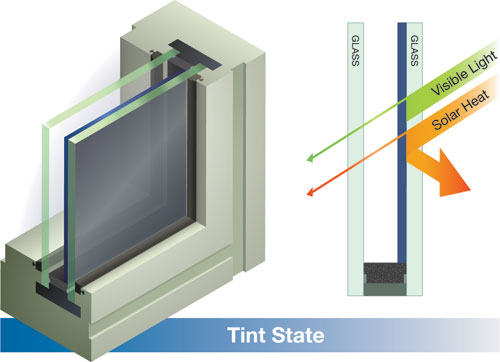Windows on Sustainability
Many Coating Options
Sputter low-E and hybrid coatings come in many color and performance options utilizing one, two and three layers of silver, sandwiched within other metal layers. These coatings represent the best available performance in high light transmission and low solar heat gain coefficient.
Depending on how it is fabricated, low-E glass can have a neutral clear appearance and very high light-to-solar gain rations. High-performance products offer a variety of appearance and light transmission options with superior solar energy control. These products can save thousands in upfront and ongoing costs. For a comparison of various low-E products, see the chart above.
 |
 |
Low-voltage electrical current is applied to the optically active layers in the electrochromic coating, which adjusts the level of tint. Source: Guardian Industries Corp. |
Electrochromic Glass
Dynamic glass is a category of next-generation windows that can change traditionally static performance characteristics such as visible light transmittance and solar heat gain coefficient. Technologies include electrochromic (EC), thermochromic, photochromic, liquid crystal (LC) and suspended particle devices (SPD). Thermochromic and photochromic technologies change their properties based on ambient temperature and light respectively. EC, LC and SPD technologies have the advantage of electronic control of glass performance, enabling intelligent controls that can be integrated with occupant schedules, lighting levels or algorithms to increase building energy efficiency.
Probably the most energy efficient, and the only one of these technologies to have passed the ASTM standard for accelerated environmental durability, is electrochromic glass, which adapts to changing conditions—somewhat like sunglasses for a building—switching from clear to tinted on demand. With the flip of a switch, electrochromic glass can change from fully transparent to a fully darkened state and potentially in between states as well, allowing control of heat and glare in buildings without the need for shades, blinds or any type of window treatment or external shading device. Unlike permanently tinted windows, occupants enjoy unobstructed views. Whether automated, or manual, the tint level of the window can be adjusted to settings that match changing needs. It should be noted that electrochromic glass can take a short period of time to change, with the time required increasing as the glass size increases. Typical times would range between 10 and 30 minutes for commercial glass sizes.
Depending on project design, this glass technology has the potential to dramatically reduce HVAC energy consumption and peak power usage, which can result in a significant reduction in operating costs. Office lights can be dimmed in the mornings, further reducing costs. In short, electrochromic technologies enable designers to use more glass while still meeting or exceeding building energy codes and standards and improving occupant comfort.
In an electrochromic glass, a thin assembly of several layers is sandwiched between two pieces of glass, which are transparent electronic conductors. Low voltage applied to the conductors moves the ions between layers, which sparks the color change. Reversing the voltage restores transparency to the window. The power required to operate one 60-watt incandescent light bulb is enough power to operate more than 1,800 square feet of electrochromic glass.










